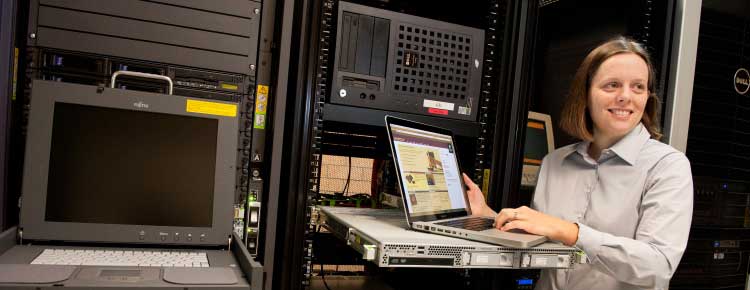Researcher Highlights
Technology troubleshooter
Dr Sarah Johnson designs complex computer codes that work behind the scenes to ensure digital communications are clearly conveyed.

Dr Sarah Johnson enjoys solving mathematical problems and her research field of error correction coding provides an endless array of numerical challenges. Error correction technologies are fundamental to digital communications, from DVD players to the National Broadband Network, and in most cases work imperceptibly in the background to correct corruptions in transmission so quickly that users are never aware of a problem.
"Just about any time we communicate, whether it is a text message to a friend or a critical communication, we are using error correction to get that message through," Johnson advises.
Error correction detects and rectifies corruptions caused to digital communications by what is broadly termed 'noise'– interference from factors such as stormy weather, physical barriers in the landscape or competition with nearby digital devices. It does not always work, as evidenced when mobile phone reception fails or a television picture momentarily drops out, but without it our communications would be far less reliable.
Johnson's research with the University's Signal Processing and Microelectronics group focuses on developing new error correction codes for next-generation communication technologies. "With digital technology expanding so rapidly, there is a growing need for better and faster error correction," she explains. "Technology that was unimaginable 10 years ago is now pushing the boundaries of our current approaches to correcting digital errors."
Designing error correction codes involves complex algorithmic computations but Johnson describes the fundamental process as adding extra numerical information to a digital message – a 'checking sequence' that bears a mathematical relationship to the original message – which can then be used to detect errors and recover the original data.
A University of Newcastle electrical engineering scholar, Johnson was awarded her PhD in 2003 and launched her research career with a fellowship at NICTA, Australia's Information and Communications Technology Research Centre of Excellence. She is now a senior researcher at the University, supported by an Australian Research Council (ARC) Future Fellowship. Her specialty field is iterative error correction coding, which has widespread application in cellular communications, digital video broadcasting and wi-fi networks.
Johnson has published in high-impact IEEE (Institute of Electrical and Electronics Engineers) journals and authored a book in 2009 titled Iterative Error Correction, through Cambridge University Press. It discusses the theory, design and implementation of powerful coding techniques known as turbo, low-density parity-check and repeat-accumulate codes.
Johnson also has a strong research interest in information theory – the analysis of the limits of error correction coding – and is working on an ARC-funded project with a University of Newcastle colleague, Dr Lawrence Ong, studying best-case scenarios for multiple-user communication networks.
"It is relatively easy to determine the best-case scenario for error correction in a traditional situation where there is only one person sending and one receiving," Johnson asserts. "It is a lot more complicated to design and understand fundamental limits in networks that have multiple people trying to communicate at the same time, which is increasingly the way people communicate today."
In a novel project, Johnson has a commercial consultancy with cyber defence company QuintessenceLabs to design a unique cryptography application for their ultra-secure electronic key systems.
"Error correction plays a vital role in so many technologies that there is an endless stream of applications for the work I do. There are so many exciting problems that keep me motivated every day."
Visit the Centre for Bioinformatics, Biomarker Discovery and Information-Based Medicine
The University of Newcastle acknowledges the traditional custodians of the lands within our footprint areas: Awabakal, Darkinjung, Biripai, Worimi, Wonnarua, and Eora Nations. We also pay respect to the wisdom of our Elders past and present.
